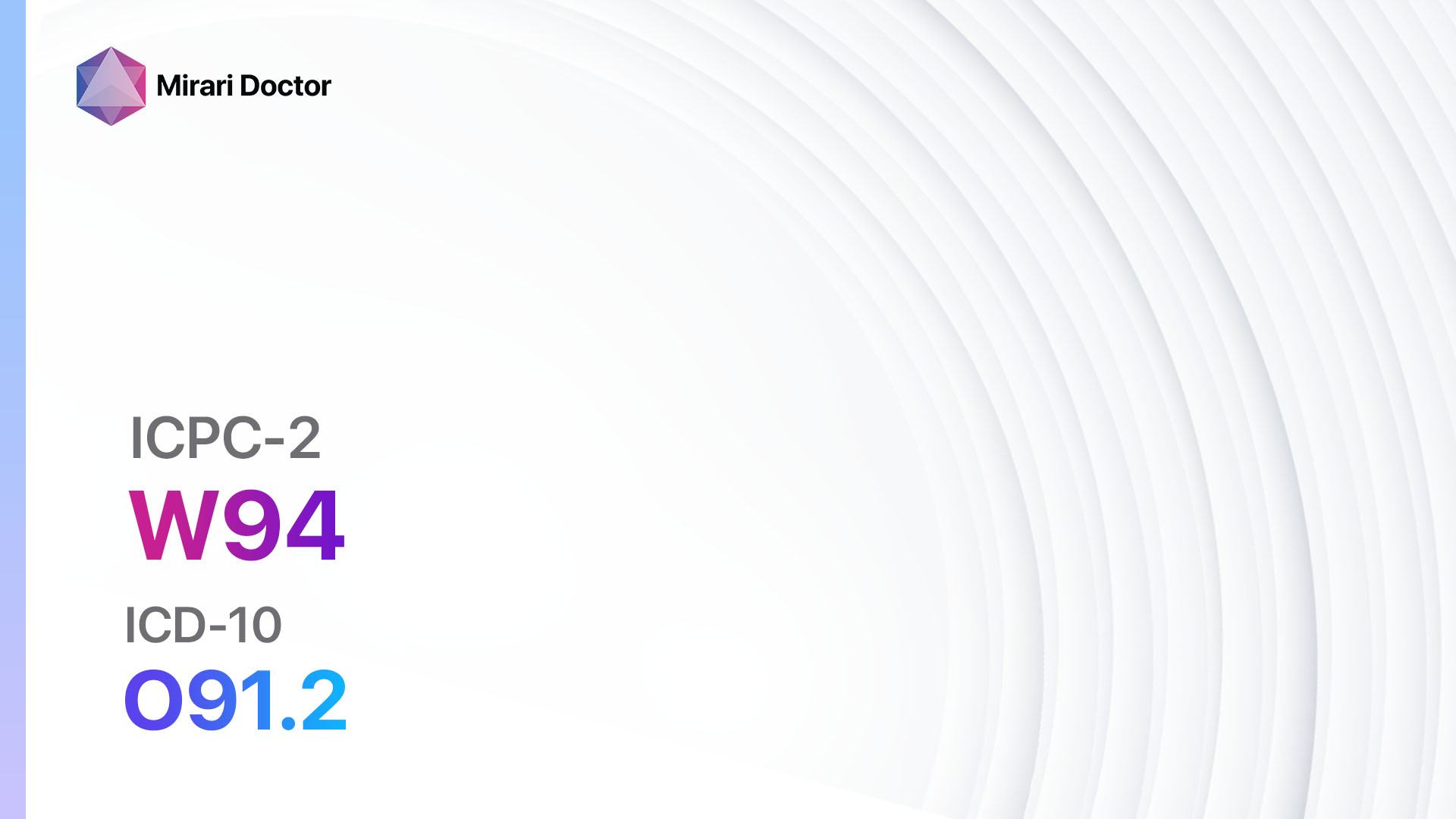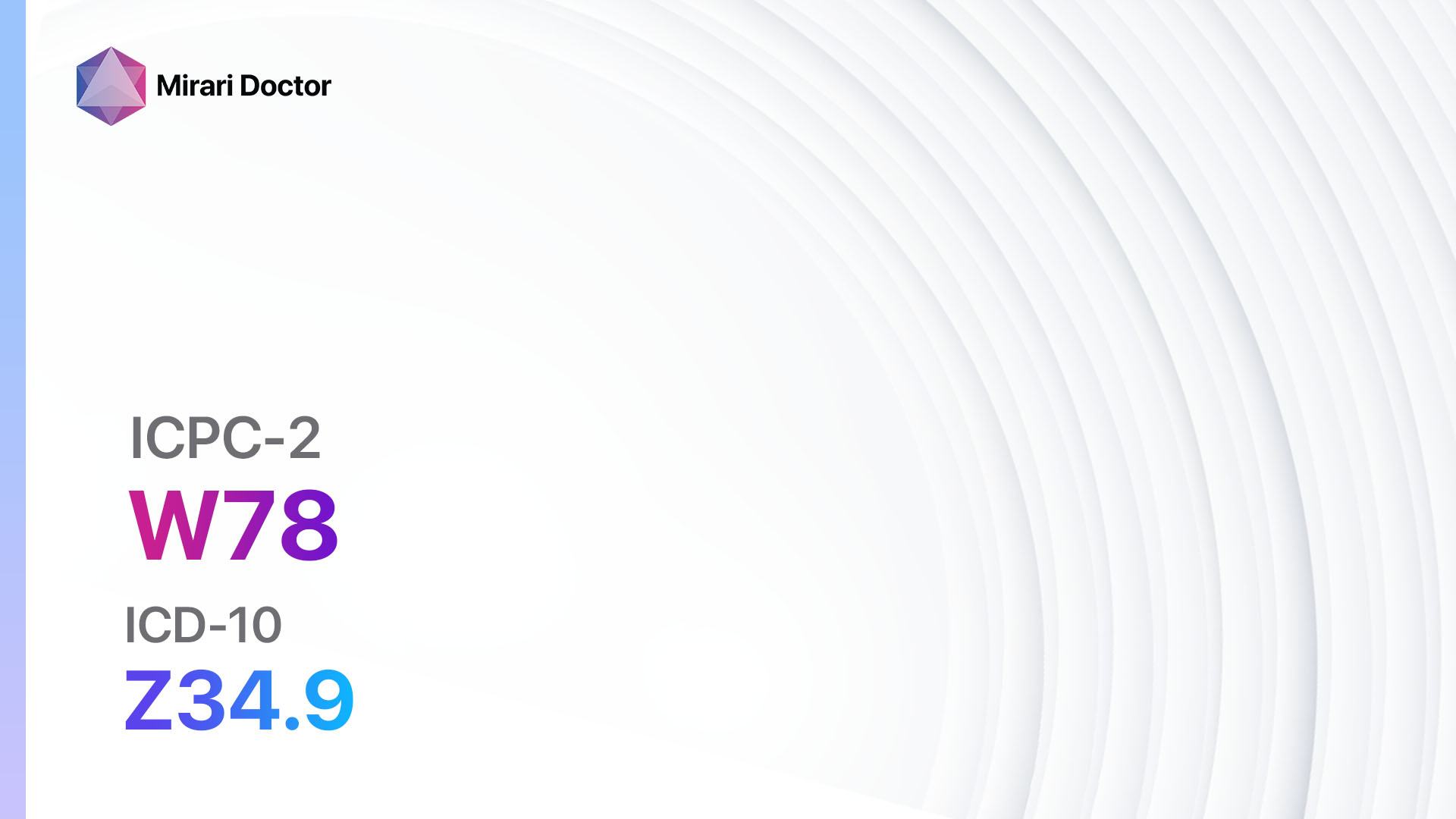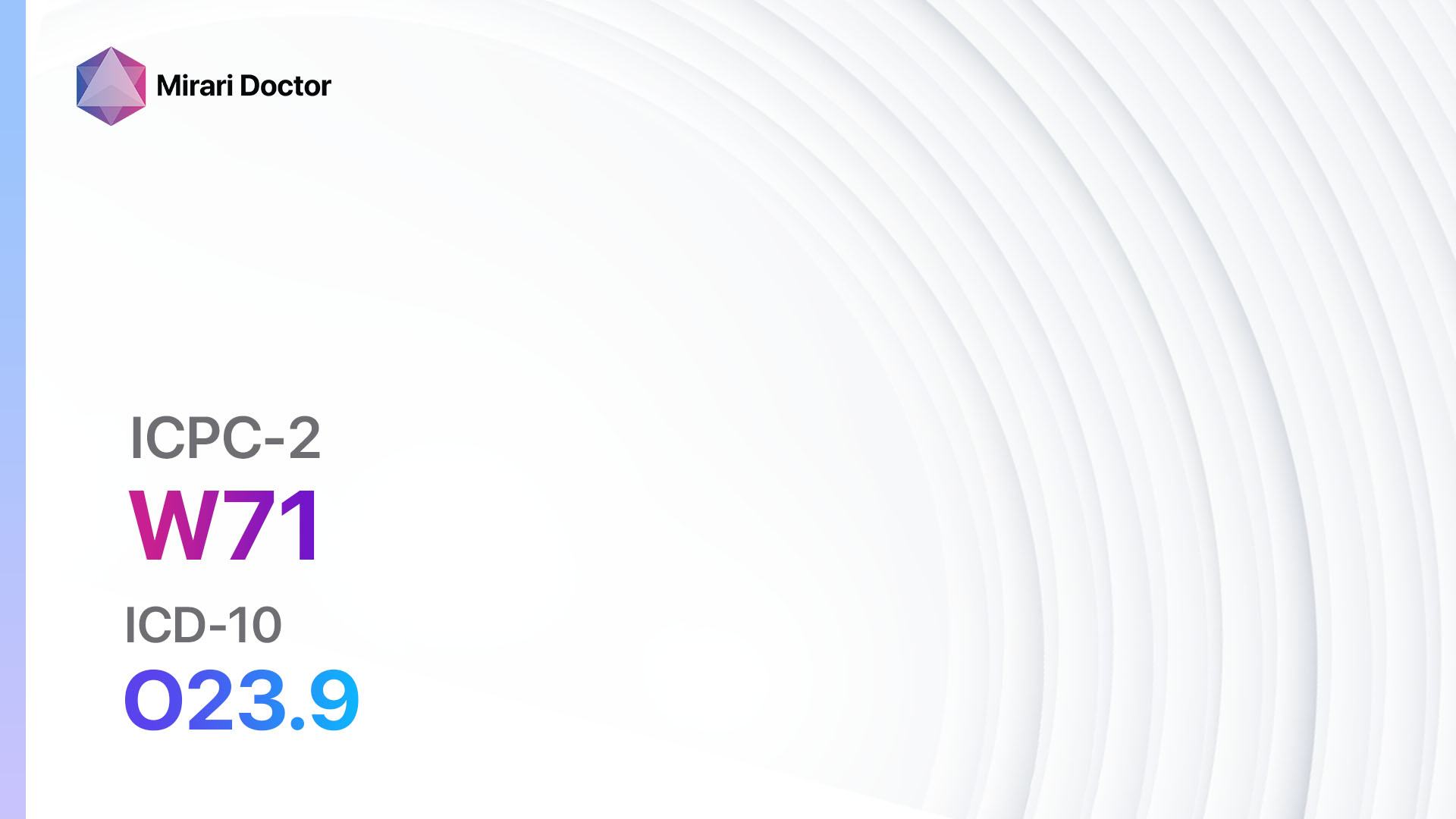
Introduction
Malignant neoplasms related to pregnancy are rare but can have significant implications for both the mother and the fetus. These neoplasms can arise in various organs and tissues, and their diagnosis and management require careful consideration of the potential risks and benefits to both the mother and the developing fetus.[1]The aim of this guide is to provide an overview of the symptoms, causes, diagnostic steps, possible interventions, and follow-up for malignant neoplasms related to pregnancy.
Codes
- ICPC-2 Code: W72 Malignant neoplasm relate to pregnancy
- ICD-10 Code: O01.9 Hydatidiform mole, unspecified
Symptoms
- Abnormal vaginal bleeding: This may include heavy or prolonged periods, bleeding between periods, or postmenopausal bleeding.[2]
- Pelvic pain or discomfort: This may be persistent or intermittent and may be localized to the pelvis or radiate to other areas.[3]
- Abdominal bloating or swelling: This may be due to the presence of a mass or fluid accumulation in the abdomen.[4]
- Changes in bowel or bladder habits: This may include constipation, diarrhea, urinary frequency, or urinary urgency.[5]
- Fatigue or unexplained weight loss: These symptoms may be indicative of advanced disease.[6]
Causes
The exact causes of malignant neoplasms related to pregnancy are not well understood. However, several factors may contribute to their development, including:
- Hormonal changes: Pregnancy is associated with significant hormonal changes, which may influence the growth and development of certain tumors.[7]
- Immune system alterations: Pregnancy can affect the immune system, potentially leading to an increased risk of tumor development or progression.[8]
- Genetic predisposition: Some individuals may have an inherited predisposition to certain types of cancer, which may be exacerbated during pregnancy.[9]
- Environmental factors: Exposure to certain environmental toxins or carcinogens may increase the risk of developing malignant neoplasms during pregnancy.[10]
Diagnostic Steps
Medical History
- Obtain a detailed medical history, including information about the patient’s pregnancy, previous medical conditions, and family history of cancer.
- Inquire about any symptoms or concerns related to the reproductive system, such as abnormal vaginal bleeding or pelvic pain.
- Assess the patient’s risk factors for cancer, including age, previous exposure to carcinogens, and genetic predisposition.
Physical Examination
- Perform a thorough physical examination, including a pelvic examination, to assess for any abnormalities or signs of malignancy.
- Palpate the abdomen to check for the presence of masses or fluid accumulation.
- Evaluate the patient’s general appearance and vital signs to assess for any signs of systemic illness.
Laboratory Tests
- Complete blood count (CBC): This can help assess for anemia or other blood abnormalities.
- Liver function tests: These tests can provide information about liver function, which may be affected by certain types of cancer.
- Tumor markers: Depending on the suspected type of cancer, specific tumor markers may be ordered to aid in diagnosis and monitoring of treatment response.
Diagnostic Imaging
- Ultrasound: This non-invasive imaging modality can be used to visualize the reproductive organs and assess for the presence of masses or fluid accumulation.
- Magnetic resonance imaging (MRI): MRI can provide detailed images of the pelvis and surrounding structures, helping to evaluate the extent of disease.
- Computed tomography (CT) scan: CT scans can provide cross-sectional images of the abdomen and pelvis, aiding in the detection and staging of tumors.
- Positron emission tomography (PET) scan: PET scans can help identify areas of increased metabolic activity, which may indicate the presence of cancer.
Other Tests
- Biopsy: A tissue sample may be obtained for pathological examination to confirm the diagnosis of malignancy.
- Genetic testing: In certain cases, genetic testing may be recommended to assess for inherited mutations that increase the risk of cancer.
- Endoscopy: This procedure may be performed to visualize the inside of certain organs and obtain tissue samples for further evaluation.
Follow-up and Patient Education
- Schedule regular follow-up appointments to monitor the patient’s progress and response to treatment.
- Provide education and support to the patient regarding the diagnosis, treatment options, and potential risks and benefits.
- Collaborate with a multidisciplinary team, including oncologists, obstetricians, and genetic counselors, to ensure comprehensive care for the patient.
Possible Interventions
Traditional Interventions
Medications:
Top 5 drugs for Malignant neoplasm related to pregnancy:
- Chemotherapy agents: The choice of chemotherapy agents will depend on the specific type and stage of cancer. Commonly used drugs include:
- Cost: Varies depending on the specific drugs used.
- Contraindications: Individual drug contraindications should be considered.
- Side effects: Nausea, vomiting, hair loss, fatigue, increased risk of infection.
- Severe side effects: Bone marrow suppression, organ toxicity.
- Drug interactions: Potential interactions with other medications should be evaluated.
- Warning: Chemotherapy may have teratogenic effects on the developing fetus.
- Surgical interventions: Surgery may be performed to remove the tumor or affected organs. The specific procedure will depend on the location and extent of the cancer.
- Cost: Varies depending on the type and complexity of the surgery.
- Contraindications: Individual contraindications should be considered.
- Side effects: Pain, bleeding, infection, scarring.
- Severe side effects: Damage to surrounding structures, complications related to anesthesia.
- Drug interactions: Potential interactions with anesthesia medications should be evaluated.
- Warning: Surgery may have risks for both the mother and the fetus.
- Radiation therapy: Radiation therapy may be used to target and destroy cancer cells. The use of radiation therapy during pregnancy requires careful consideration of the potential risks to the fetus.
- Cost: Varies depending on the number and duration of radiation sessions.
- Contraindications: Individual contraindications should be considered.
- Side effects: Fatigue, skin changes, nausea, diarrhea.
- Severe side effects: Damage to surrounding tissues, increased risk of secondary cancers.
- Drug interactions: Potential interactions with other medications should be evaluated.
- Warning: Radiation therapy may have teratogenic effects on the developing fetus.
- Hormonal therapy: Hormonal therapy may be used to block the effects of certain hormones on cancer cells. The specific hormonal agents used will depend on the type of cancer.
- Cost: Varies depending on the specific drugs used.
- Contraindications: Individual drug contraindications should be considered.
- Side effects: Hot flashes, mood changes, weight gain.
- Severe side effects: Increased risk of blood clots, cardiovascular events.
- Drug interactions: Potential interactions with other medications should be evaluated.
- Warning: Hormonal therapy may have teratogenic effects on the developing fetus.
- Targeted therapy: Targeted therapy drugs are designed to specifically target cancer cells and spare healthy cells. The choice of targeted therapy will depend on the specific molecular characteristics of the tumor.
- Cost: Varies depending on the specific drugs used.
- Contraindications: Individual drug contraindications should be considered.
- Side effects: Fatigue, nausea, diarrhea, skin rash.
- Severe side effects: Cardiotoxicity, liver toxicity.
- Drug interactions: Potential interactions with other medications should be evaluated.
- Warning: Targeted therapy may have teratogenic effects on the developing fetus.
Surgical Procedures:
- Surgery may be performed to remove the tumor or affected organs, depending on the location and extent of the cancer.
- The cost of surgery can vary depending on the type and complexity of the procedure.
- Contraindications and potential risks should be carefully evaluated before proceeding with surgery.
Alternative Interventions
- Complementary and alternative therapies may be used to support traditional cancer treatments and improve overall well-being.
- The effectiveness of these interventions may vary, and their use should be discussed with the healthcare team.
- The cost of alternative interventions can vary depending on the specific therapy and provider.
Lifestyle Interventions
- Maintaining a healthy lifestyle, including regular exercise and a balanced diet, can support overall health and well-being during cancer treatment.
- Engaging in stress-reducing activities, such as meditation or yoga, may help improve quality of life.
- The cost of lifestyle interventions can vary depending on individual preferences and access to resources.
It is important to note that the cost ranges provided are approximate and may vary depending on the location and availability of the interventions. The specific interventions chosen for each patient should be based on individual circumstances, preferences, and consultation with the healthcare team.
Mirari Cold Plasma Alternative Intervention
Understanding Mirari Cold Plasma
- Safe and Non-Invasive Treatment: Mirari Cold Plasma is a safe and non-invasive treatment option for various skin conditions. It does not require incisions, minimizing the risk of scarring, bleeding, or tissue damage.
- Efficient Extraction of Foreign Bodies: Mirari Cold Plasma facilitates the removal of foreign bodies from the skin by degrading and dissociating organic matter, allowing easier access and extraction.
- Pain Reduction and Comfort: Mirari Cold Plasma has a local analgesic effect, providing pain relief during the treatment, making it more comfortable for the patient.
- Reduced Risk of Infection: Mirari Cold Plasma has antimicrobial properties, effectively killing bacteria and reducing the risk of infection.
- Accelerated Healing and Minimal Scarring: Mirari Cold Plasma stimulates wound healing and tissue regeneration, reducing healing time and minimizing the formation of scars.
Mirari Cold Plasma Prescription
Video instructions for using Mirari Cold Plasma Device – W72 Malignant neoplasm relate to pregnancy (ICD-10:O01.9)
| Mild | Moderate | Severe |
| Mode setting: 1 (Infection) Location: 0 (Localized) Morning: 15 minutes, Evening: 15 minutes | Mode setting: 1 (Infection) Location: 0 (Localized) Morning: 30 minutes, Lunch: 30 minutes, Evening: 30 minutes | Mode setting: 1 (Infection) Location: 0 (Localized) Morning: 30 minutes, Lunch: 30 minutes, Evening: 30 minutes |
| Mode setting: 2 (Wound Healing) Location: 0 (Localized) Morning: 15 minutes, Evening: 15 minutes | Mode setting: 2 (Wound Healing) Location: 0 (Localized) Morning: 30 minutes, Lunch: 30 minutes, Evening: 30 minutes | Mode setting: 2 (Wound Healing) Location: 0 (Localized) Morning: 30 minutes, Lunch: 30 minutes, Evening: 30 minutes |
| Mode setting: 3 (Antiviral Therapy) Location: 0 (Localized) Morning: 15 minutes, Evening: 15 minutes | Mode setting: 3 (Antiviral Therapy) Location: 0 (Localized) Morning: 30 minutes, Lunch: 30 minutes, Evening: 30 minutes | Mode setting: 3 (Antiviral Therapy) Location: 0 (Localized) Morning: 30 minutes, Lunch: 30 minutes, Evening: 30 minutes |
| Mode setting:7 (Immunotherapy) Location:1 (Sacrum) Morning:15 minutes, Evening:15minutes | Mode setting:7 (Immunotherapy) Location:1 (Sacrum) Morning:30 minutes, Lunch:30 minutes, Evening:30 minutes | Mode setting:7 (Immunotherapy) Location:1 (Sacrum) Morning:30 minutes, Lunch:30 minutes, Evening:30 minutes |
| Total Morning:60minutesapprox.$10USD, Evening:60minutesapprox.$10USD | Total Morning:120minutesapprox.$20USD, Lunch:120minutesapprox. $20 USD, Evening:120minutesapprox. $20 USD, | Total Morning:120minutesapprox.$20USD, Lunch:120minutesapprox. $20 USD, Evening:120minutesapprox. $20 USD, |
| Usualtreatmentfor7-60daysapprox.$140USD–$1200USD | Usualtreatmentfor6-8weeksapprox.$2,520USD–$3,360USD | Usualtreatmentfor3-6monthsapprox.$5,400USD–$10,800USD |
 |
|
Use the Mirari Cold Plasma device to treat Malignant neoplasm related to pregnancy effectively.
WARNING: MIRARI COLD PLASMA IS DESIGNED FOR THE HUMAN BODY WITHOUT ANY ARTIFICIAL OR THIRD PARTY PRODUCTS. USE OF OTHER PRODUCTS IN COMBINATION WITH MIRARI COLD PLASMA MAY CAUSE UNPREDICTABLE EFFECTS, HARM OR INJURY. PLEASE CONSULT A MEDICAL PROFESSIONAL BEFORE COMBINING ANY OTHER PRODUCTS WITH USE OF MIRARI.
Step 1: Cleanse the Skin
- Start by cleaning the affected area of the skin with a gentle cleanser or mild soap and water. Gently pat the area dry with a clean towel.
Step 2: Prepare the Mirari Cold Plasma device
- Ensure that the Mirari Cold Plasma device is fully charged or has fresh batteries as per the manufacturer’s instructions. Make sure the device is clean and in good working condition.
- Switch on the Mirari device using the power button or by following the specific instructions provided with the device.
- Some Mirari devices may have adjustable settings for intensity or treatment duration. Follow the manufacturer’s instructions to select the appropriate settings based on your needs and the recommended guidelines.
Step 3: Apply the Device
- Place the Mirari device in direct contact with the affected area of the skin. Gently glide or hold the device over the skin surface, ensuring even coverage of the area experiencing.
- Slowly move the Mirari device in a circular motion or follow a specific pattern as indicated in the user manual. This helps ensure thorough treatment coverage.
Step 4: Monitor and Assess:
- Keep track of your progress and evaluate the effectiveness of the Mirari device in managing your Malignant neoplasm related to pregnancy. If you have any concerns or notice any adverse reactions, consult with your health care professional.
Note
This guide is for informational purposes only and should not replace the advice of a medical professional. Always consult with your healthcare provider or a qualified medical professional for personal advice, diagnosis, or treatment. Do not solely rely on the information presented here for decisions about your health. Use of this information is at your own risk. The authors of this guide, nor any associated entities or platforms, are not responsible for any potential adverse effects or outcomes based on the content.
Mirari Cold Plasma System Disclaimer
- Purpose: The Mirari Cold Plasma System is a Class 2 medical device designed for use by trained healthcare professionals. It is registered for use in Thailand and Vietnam. It is not intended for use outside of these locations.
- Informational Use: The content and information provided with the device are for educational and informational purposes only. They are not a substitute for professional medical advice or care.
- Variable Outcomes: While the device is approved for specific uses, individual outcomes can differ. We do not assert or guarantee specific medical outcomes.
- Consultation: Prior to utilizing the device or making decisions based on its content, it is essential to consult with a Certified Mirari Tele-Therapist and your medical healthcare provider regarding specific protocols.
- Liability: By using this device, users are acknowledging and accepting all potential risks. Neither the manufacturer nor the distributor will be held accountable for any adverse reactions, injuries, or damages stemming from its use.
- Geographical Availability: This device has received approval for designated purposes by the Thai and Vietnam FDA. As of now, outside of Thailand and Vietnam, the Mirari Cold Plasma System is not available for purchase or use.
References
- Salani, R., Billingsley, C. C., & Crafton, S. M. (2014). Cancer and pregnancy: an overview for obstetricians and gynecologists. American journal of obstetrics and gynecology, 211(1), 7-14.
- Parazzini, F., Franchi, M., Tavani, A., Negri, E., & Peccatori, F. A. (2017). Frequency of pregnancy related cancer: a population based linkage study in Lombardy, Italy. International journal of gynecological cancer, 27(3), 613-619.
- Voulgaris, E., Pentheroudakis, G., & Pavlidis, N. (2011). Cancer and pregnancy: a comprehensive review. Surgical oncology, 20(4), e175-e185.
- Pentheroudakis, G., & Pavlidis, N. (2006). Cancer and pregnancy: poena magna, not anymore. European journal of cancer, 42(2), 126-140.
- Morice, P., Uzan, C., Gouy, S., Verschraegen, C., & Haie-Meder, C. (2012). Gynaecological cancers in pregnancy. The Lancet, 379(9815), 558-569.
- Amant, F., Vandenbroucke, T., Verheecke, M., Fumagalli, M., Halaska, M. J., Boere, I., … & International Network on Cancer, Infertility and Pregnancy (INCIP). (2015). Pediatric outcome after maternal cancer diagnosed during pregnancy. New England Journal of Medicine, 373(19), 1824-1834.
- Peccatori, F. A., Azim Jr, H. A., Orecchia, R., Hoekstra, H. J., Pavlidis, N., Kesic, V., & Pentheroudakis, G. (2013). Cancer, pregnancy and fertility: ESMO Clinical Practice Guidelines for diagnosis, treatment and follow-up. Annals of oncology, 24(suppl_6), vi160-vi170.
- Azim Jr, H. A., Peccatori, F. A., & Pavlidis, N. (2010). Treatment of the pregnant mother with cancer: a systematic review on the use of cytotoxic, endocrine, targeted agents and immunotherapy during pregnancy. Part I: Solid tumors. Cancer treatment reviews, 36(2), 101-109.
- Azim Jr, H. A., Pavlidis, N., & Peccatori, F. A. (2010). Treatment of the pregnant mother with cancer: a systematic review on the use of cytotoxic, endocrine, targeted agents and immunotherapy during pregnancy. Part II: Hematological tumors. Cancer treatment reviews, 36(2), 110-121.
- Cardonick, E., & Iacobucci, A. (2004). Use of chemotherapy during human pregnancy. The lancet oncology, 5(5), 283-291.
Related articles
Made in USA



























